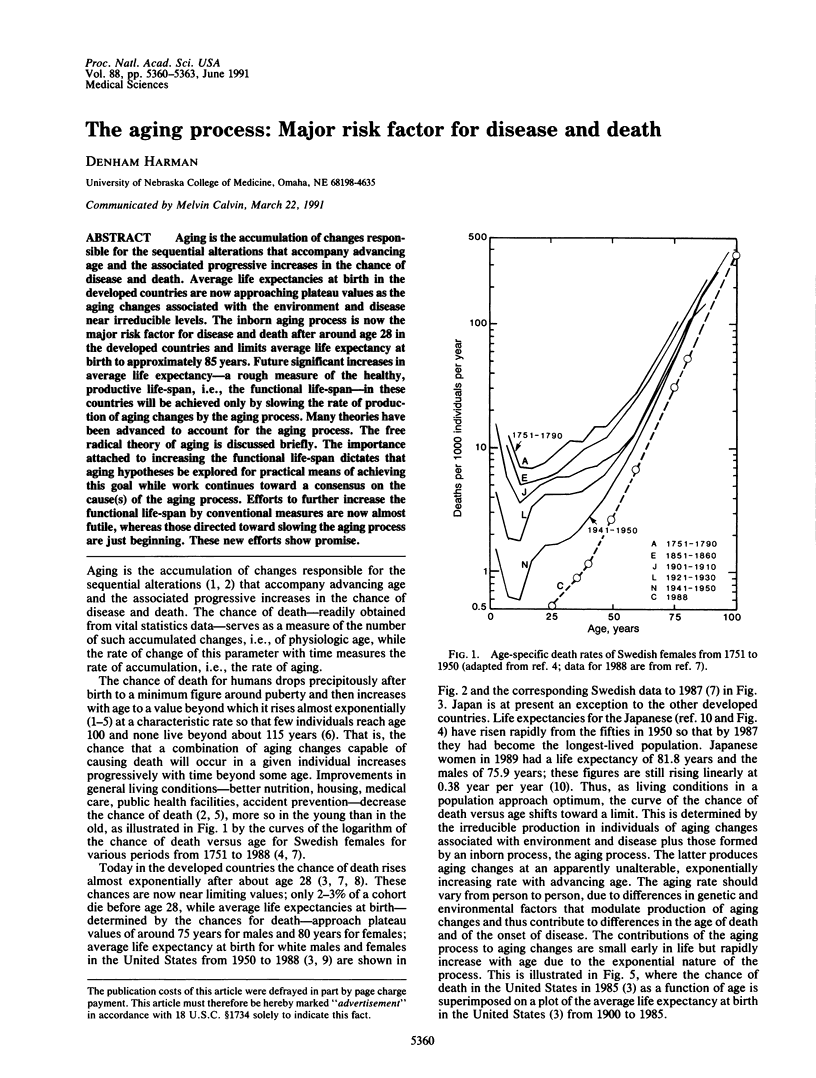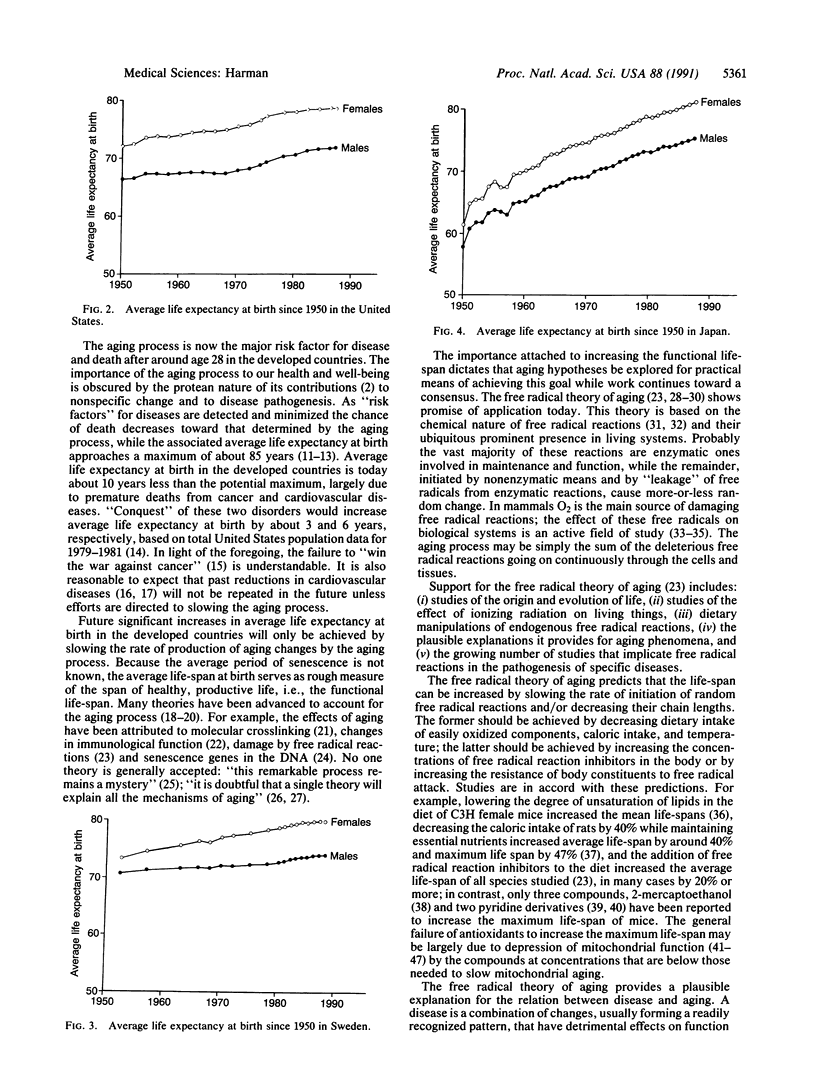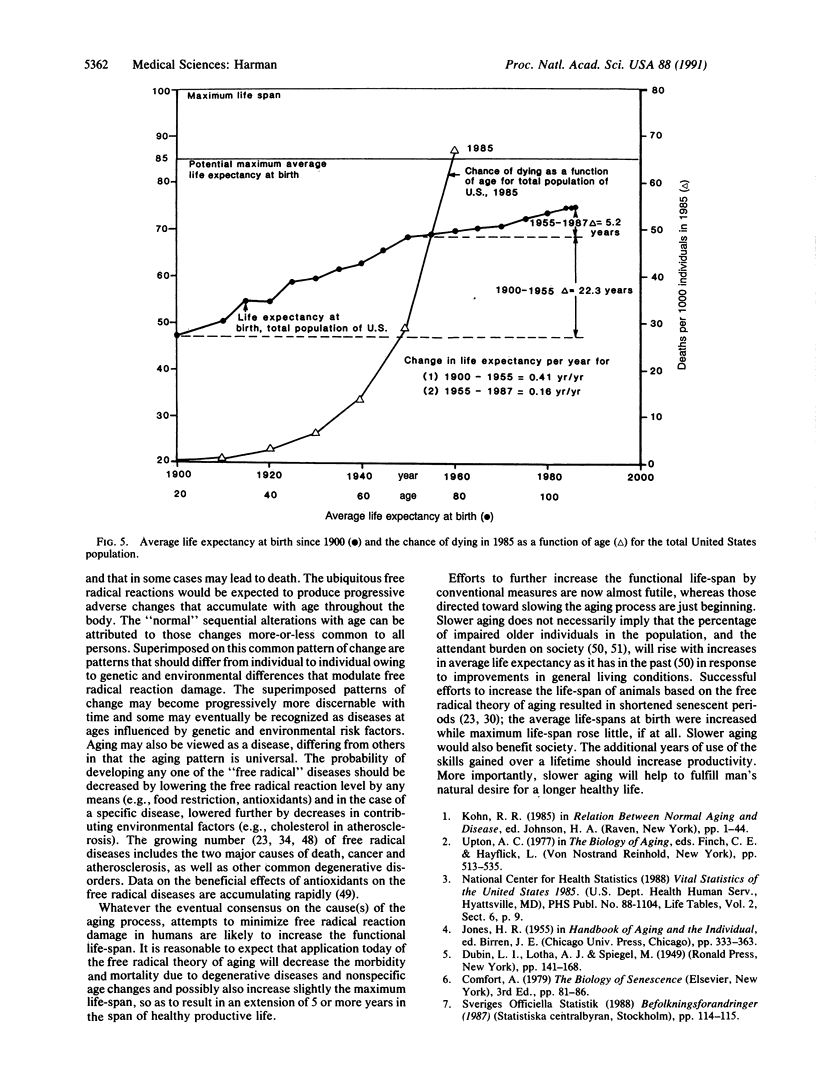Abstract
Aging is the accumulation of changes responsible for the sequential alterations that accompany advancing age and the associated progressive increases in the chance of disease and death. Average life expectancies at birth in the developed countries are now approaching plateau values as the aging changes associated with the environment and disease near irreducible levels. The inborn aging process is now the major risk factor for disease and death after around age 28 in the developed countries and limits average life expectancy at birth to approximately 85 years. Future significant increases in average life expectancy--a rough measure of the healthy, productive life-span, i.e., the functional life-span--in these countries will be achieved only by slowing the rate of production of aging changes by the aging process. Many theories have been advanced to account for the aging process. The free radical theory of aging is discussed briefly. The importance attached to increasing the functional life-span dictates that aging hypotheses be explored for practical means of achieving this goal while work continues toward a consensus on the cause(s) of the aging process. Efforts to further increase the functional life-span by conventional measures are now almost futile, whereas those directed toward slowing the aging process are just beginning. These new efforts show promise.
Full text
PDF



Selected References
These references are in PubMed. This may not be the complete list of references from this article.
- Bailar J. C., 3rd, Smith E. M. Progress against cancer? N Engl J Med. 1986 May 8;314(19):1226–1232. doi: 10.1056/NEJM198605083141905. [DOI] [PubMed] [Google Scholar]
- Bandy B., Davison A. J. Mitochondrial mutations may increase oxidative stress: implications for carcinogenesis and aging? Free Radic Biol Med. 1990;8(6):523–539. doi: 10.1016/0891-5849(90)90152-9. [DOI] [PubMed] [Google Scholar]
- Bjorksten J. The crosslinkage theory of aging. J Am Geriatr Soc. 1968 Apr;16(4):408–427. doi: 10.1111/j.1532-5415.1968.tb02821.x. [DOI] [PubMed] [Google Scholar]
- Emanuel N. M. Free radicals and the action of inhibitors of radical processes under pathological states and ageing in living organisms and in man. Q Rev Biophys. 1976 May;9(2):283–308. doi: 10.1017/s0033583500002420. [DOI] [PubMed] [Google Scholar]
- Fleming J. E., Miquel J., Cottrell S. F., Yengoyan L. S., Economos A. C. Is cell aging caused by respiration-dependent injury to the mitochondrial genome? Gerontology. 1982;28(1):44–53. doi: 10.1159/000212510. [DOI] [PubMed] [Google Scholar]
- Freeman B. A., Crapo J. D. Biology of disease: free radicals and tissue injury. Lab Invest. 1982 Nov;47(5):412–426. [PubMed] [Google Scholar]
- Fries J. F. Aging, natural death, and the compression of morbidity. N Engl J Med. 1980 Jul 17;303(3):130–135. doi: 10.1056/NEJM198007173030304. [DOI] [PubMed] [Google Scholar]
- HARMAN D. Aging: a theory based on free radical and radiation chemistry. J Gerontol. 1956 Jul;11(3):298–300. doi: 10.1093/geronj/11.3.298. [DOI] [PubMed] [Google Scholar]
- HARMAN D. Role of free radicals in mutation, cancer, aging, and the maintenance of life. Radiat Res. 1962 May;16:753–763. [PubMed] [Google Scholar]
- Harman D. Free radical theory of aging: effect of the amount and degree of unsaturation of dietary fat on mortality rate. J Gerontol. 1971 Oct;26(4):451–457. doi: 10.1093/geronj/26.4.451. [DOI] [PubMed] [Google Scholar]
- Harman D. The aging process. Proc Natl Acad Sci U S A. 1981 Nov;78(11):7124–7128. doi: 10.1073/pnas.78.11.7124. [DOI] [PMC free article] [PubMed] [Google Scholar]
- Harman D. The biologic clock: the mitochondria? J Am Geriatr Soc. 1972 Apr;20(4):145–147. doi: 10.1111/j.1532-5415.1972.tb00787.x. [DOI] [PubMed] [Google Scholar]
- Heidrick M. L., Hendricks L. C., Cook D. E. Effect of dietary 2-mercaptoethanol on the life span, immune system, tumor incidence and lipid peroxidation damage in spleen lymphocytes of aging BC3F1 mice. Mech Ageing Dev. 1984 Oct 31;27(3):341–358. doi: 10.1016/0047-6374(84)90057-5. [DOI] [PubMed] [Google Scholar]
- Levit K. R., Freeland M. S. DataWatch. National medical care spending. Health Aff (Millwood) 1988 Winter;7(5):124–136. doi: 10.1377/hlthaff.7.5.124. [DOI] [PubMed] [Google Scholar]
- Levy R. I., Moskowitz J. Cardiovascular research: decades of progress, a decade of promise. Science. 1982 Jul 9;217(4555):121–129. doi: 10.1126/science.7046047. [DOI] [PubMed] [Google Scholar]
- Medvedev Z. A. An attempt at a rational classification of theories of ageing. Biol Rev Camb Philos Soc. 1990 Aug;65(3):375–398. doi: 10.1111/j.1469-185x.1990.tb01428.x. [DOI] [PubMed] [Google Scholar]
- Miquel J., Economos A. C., Fleming J., Johnson J. E., Jr Mitochondrial role in cell aging. Exp Gerontol. 1980;15(6):575–591. doi: 10.1016/0531-5565(80)90010-8. [DOI] [PubMed] [Google Scholar]
- Olshansky S. J., Carnes B. A., Cassel C. In search of Methuselah: estimating the upper limits to human longevity. Science. 1990 Nov 2;250(4981):634–640. doi: 10.1126/science.2237414. [DOI] [PubMed] [Google Scholar]
- Richter C., Park J. W., Ames B. N. Normal oxidative damage to mitochondrial and nuclear DNA is extensive. Proc Natl Acad Sci U S A. 1988 Sep;85(17):6465–6467. doi: 10.1073/pnas.85.17.6465. [DOI] [PMC free article] [PubMed] [Google Scholar]
- Schneider E. L., Guralnik J. M. The aging of America. Impact on health care costs. JAMA. 1990 May 2;263(17):2335–2340. [PubMed] [Google Scholar]
- Sytkowski P. A., Kannel W. B., D'Agostino R. B. Changes in risk factors and the decline in mortality from cardiovascular disease. The Framingham Heart Study. N Engl J Med. 1990 Jun 7;322(23):1635–1641. doi: 10.1056/NEJM199006073222304. [DOI] [PubMed] [Google Scholar]
- Vijg J. Searching for the molecular basis of aging: the need for life extension models. Aging (Milano) 1990 Sep;2(3):227–229. doi: 10.1007/BF03323922. [DOI] [PubMed] [Google Scholar]
- WOODHALL B., JABLON S. Prospects for further increase in average longevity. Geriatrics. 1957 Oct;12(10):586–591. [PubMed] [Google Scholar]
- Yu B. P., Masoro E. J., Murata I., Bertrand H. A., Lynd F. T. Life span study of SPF Fischer 344 male rats fed ad libitum or restricted diets: longevity, growth, lean body mass and disease. J Gerontol. 1982 Mar;37(2):130–141. doi: 10.1093/geronj/37.2.130. [DOI] [PubMed] [Google Scholar]


